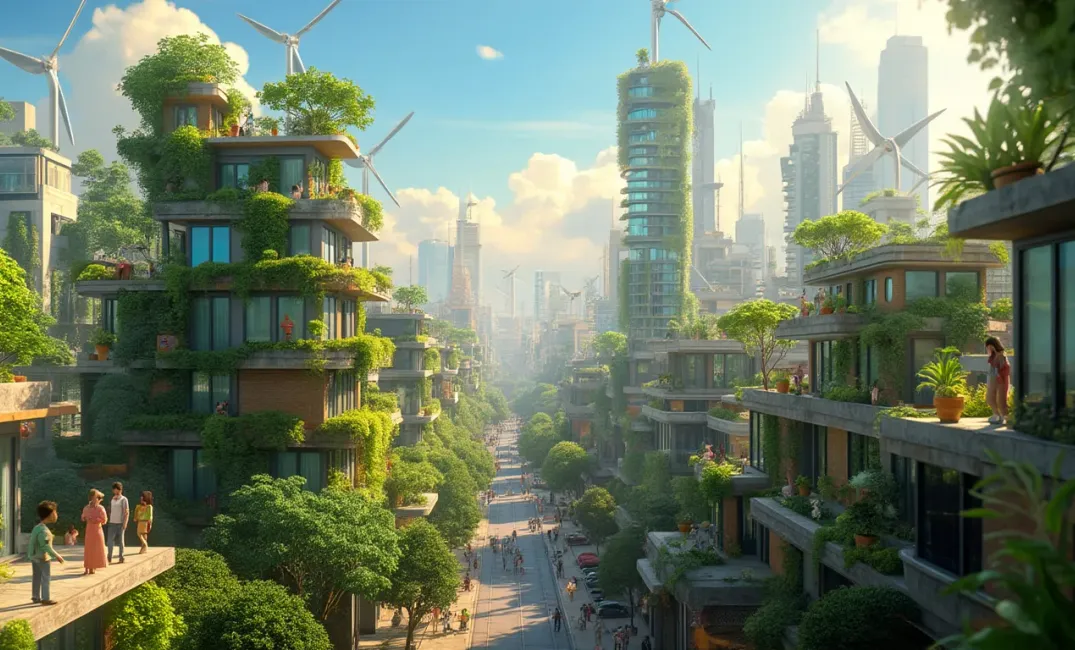Introduction: Bridging Nature and Design
Architecture is a reflection of human ambition, a tangible manifestation of our civilizations’ imagination and innovation. Yet, in our quest to shape built environments, we have often overlooked the delicate balance between human progress and ecological harmony. As we advance into a future fraught with environmental challenges, the necessity of designing buildings that coexist with nature is more vital than ever. This entry explores the integration of architecture and sustainability, laying down principles for future designs that honor the planet's well-being while accommodating humanity's needs.
"The mother art is architecture. Without an architecture of our own we have no soul of our own civilization." — Frank Lloyd Wright
The Evolution of Green Architecture: A Historical Perspective
Roots in Ancient Practices
- Traditional Harmonies with Nature: Ancient civilizations demonstrated architectural ingenuity by utilizing local materials and responding directly to their surroundings. The earthen structures of Mesopotamia, wood and rice straw houses in Japan, and stone structures built into the cliffs by the Ancestral Puebloans in the American southwest exemplify cultures that worked in tandem with nature.
- Indigenous Knowledge in Sustainability: Indigenous communities worldwide have incorporated sustainable practices into their building techniques for centuries. Structures like the Igloos of the Inuit and the Maloca houses of the Amazon embrace local environments with minimal ecological disturbance.
The Rise of Modern Green Architecture
- The Birth of Environmental Awareness: The 20th century brought the realization of industrial pollution's impact on the environment. Pioneers like Frank Lloyd Wright emphasized organic architecture, blending constructions with their surroundings, while Rachel Carson's "Silent Spring" highlighted the broader ecological consequences of unchecked development.
- The Emergence of Sustainable Architecture: By the late 20th century, architects prioritized environmental responsibility. The term "green building" gained traction, emphasizing efficiency in energy, water, and resource consumption, alongside reducing waste, pollution, and environmental degradation.
Principles of Sustainable Architecture
Designing for Energy Efficiency
- Harnessing Renewable Energy: Employing solar panels, geothermal systems, and wind turbines allows constructions to generate their power sustainably. Passive solar design, which maximizes natural light and heat, reduces dependency on artificial lighting and heating.
- Smart Building Technologies: Modern technology enables buildings to adapt dynamically to user behaviors and environmental conditions. Smart thermostats, automated lighting, and energy-saving fixtures enhance energy efficiency.
Materials and Resource Conservation
- Upcycling and Reuse: Sourcing materials such as salvaged wood, steel, and brick reduces waste. Upcycling existing materials minimizes the need for new resources while lowering carbon footprints.
- Innovative Sustainable Materials: Advances in technology produce materials with minimal environmental impact, like bamboo, recycled steel, and low-impact concrete. Green roofs and living walls not only add aesthetic appeal but also improve air quality and decrease urban heat.
Water Management and Conservation
- Efficient Water Use: Low-flow fixtures, dual-flush toilets, and efficient irrigation systems reduce water demand. Rainwater harvesting and greywater recycling systems repurpose water for landscaping and, where appropriate, internal uses like flushing toilets.
- Landscaping and Biodiversity: Choosing native vegetation reduces the need for irrigation and fertilizers, supporting natural ecosystems.
Iconic Sustainable Architectural Marvels
Beacon Projects and Their Impact
- The Eden Project, UK: This massive collection of biomes emulates a rainforest environment inside giant greenhouses, fostering biodiversity and public awareness of nature's magnificence and fragility.
- Bosco Verticale, Italy: These "Vertical Forests" bring a new definition to urban living, with vegetation integrated directly into high-rise buildings, providing aesthetic beauty and improving air quality.
- The Bullitt Center, USA: Dubbed the greenest commercial building in the world, it produces more energy than it consumes, boasts a full-water recycling system, and was built using locally sourced materials.
Lessons and Innovations from These Achievements
- Holistic Integration: Passionate collaborative efforts between architects, ecologists, and engineers allow bold designs to flourish, meeting ecological and human goals harmoniously.
- Community Engagement and Education: Engaging local communities around sustainable projects fosters broader understanding and stewardship of the environment, with iconic buildings becoming symbols of collective pride and progress.
Challenges and Future Directions
Overcoming Barriers to Sustainable Building
- Economic and Regulatory Hurdles: Initial investments in sustainable designs can be cost-prohibitive without incentives or subsidies. Comprehensive policy frameworks at national and local scales are crucial to transform market norms.
- Cultural Shifts and Perception: Encouraging mass transition toward sustainable architecture requires reshaping cultural values, emphasizing long-term advantages over immediate costs, and nurturing an environmental ethos.
Catalyzing Innovation Through Collaboration
- Global Partnerships and Sharing: Open-source platforms and international collaborations enable sharing best practices and innovations. Policy and design models adaptable to diverse cultural and environmental contexts promote localized sustainable practices.
- Research and Development: Governments, corporations, and academia must drive research into new materials, methods, and technologies, focusing on climate adaptability and resource efficiency, spurred by decreasing carbon thresholds.
Envisioning a Sustainable Future Through Design
Dreaming of Tomorrow's Cities
- Biophilic Urban Environments: Nature-inspired designs prioritize greenery, light, and natural elements within urban settings, fostering wellness and minimizing environmental footprints.
- Circular Economies in Construction: Full lifecycle analysis for buildings ensures minimal waste, with materials reused and repurposed to create closed-loop systems for optimal sustainability.
The Role of Education and Awareness
- Empowering a New Generation: Education centers and architecture schools should incorporate ecological stewardship into their core ethos, promoting sustainable goals in curricula, projects, and communities.
- Design as a Catalyst for Cultural Transformation: Buildings must embody aspirational values for communities to unite around, with educational programs and public engagement initiatives amplifying messages of ecological responsibility.
Conclusion: Building Beyond Structures
The integration of architecture and nature represents humanity’s profound opportunity to forge a future where our built environment respects and elevates the ecosystems supporting it. As we design spaces for dwelling, work, and play, the balance of sustainability and innovation forms the cornerstone of our responsibility to the Earth and future generations.
By embracing these sustainable options, the coming generations can redefine civilization's architectural grandiosity as one not merely of concrete and steel but of living, breathing harmonies with the environment. Our creative offerings, painted not with broad destructive strokes but with thoughtful respect and collaboration, demonstrate that human society can simultaneously thrive and sustain the planet.
"Architecture is the learned game, correct and magnificent, of forms assembled in the light." — Le Corbusier
SUSTAINABLE MATERIALS, WATER MANAGEMENT, ARCHITECTURE, RENEWABLE ENERGY, CULTURAL TRANSFORMATION, GREEN BUILDING, ICONIC BUILDINGS, SUSTAINABILITY, FUTURE CITIES, ENVIRONMENTAL DESIGN

